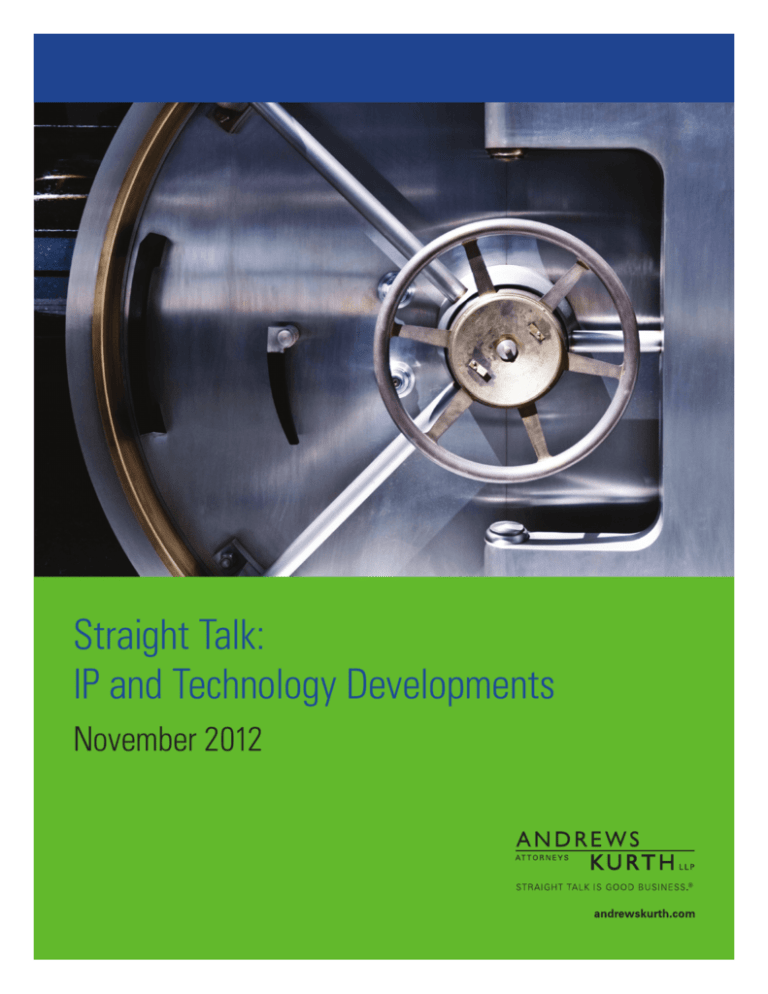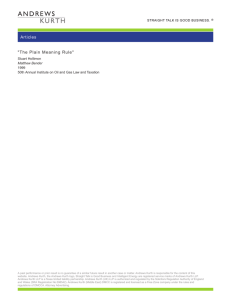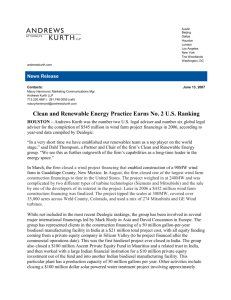
Straight Talk:
IP and Technology Developments
November 2012
STRAIGHT TALK IS GOOD BUSINESS. ®
Ar ticles
Second Circuit Clar ifies E-Commerce Contract For mation Requirements
Dean W. Harvey and Thomas G. Woolsey
IP and Tech Developments - November 2012
November 28, 2012
A common concern with online terms of use and other electronic contracts is that, on their face, they do not meet all of the
required elements necessary for the formation of an enforceable contract. It can be difficult to determine whether a single
contract or a series of smaller contracts was formed. Questions surrounding offers, acceptance and counteroffers may
complicate the analysis. These difficulties can bring into question whether there was a meeting of the minds between a
company and its customer, and may open the door to questions regarding the timing of contract formation and its effect on
the terms later provided.
Shrink-wrap v. Click-wrap v. Browse-wrap Contracts
Shrink-wrap contracts entered widespread use in the 1980s and 1990s. Many of the leading cases regarding contracts that
contain additional terms after the purchase of the products were developed in connection with software purchases. Due to
spatial limitations, the only way to include all of the terms of a contract was to separate some of the terms and enclose them
within the packaging. Even though required elements of contract formation were missing such as notice of the terms, and
mutual assent thereto, courts slowly came to accept shrink-wrap contracts provided that the customer was able to return the
product within a reasonable period of time. In ProCD v. Zeidenberg,1 the Seventh Circuit held that Zeidenberg was bound by
the terms and conditions of a software license included in a users’ manual within the packaging, and which was displayed
on a computer screen upon installation and use of the software. The Seventh Circuit held that “[Shrink-wrap] licenses are
enforceable unless their terms are objectionable on grounds applicable to contracts in general.”2
Browse-wrap contracts display the terms and conditions of a contract somewhere on a webpage but do not require the
customer to acknowledge the terms. Proponents of browse-wrap contracts have argued that they are logically
indistinguishable from shrink-wrap contracts insofar as additional terms are available to the customer, even if there is no
actual notice and assent. However, the seminal case regarding the enforceability of such contracts in e-commerce is Specht
v. Netscape Communications.3 In Specht, the Second Circuit held that downloading free software from Netscape’s website
without manifesting assent to the software license terms located at the bottom of the webpage did not form an enforceable
contract.4 The Court identified two central issues in Specht: (i) a lack of notice of the contractual terms, and (ii)
unambiguous manifestation of assent.5 This latter point has given rise to the distinction between browse-wrap contracts and
click-wrap contracts. Browse-wrap contracts are generally held to be unenforceable because there is no manifestation of
assent. Click-wrap contracts require customers to click an “I Agree” button on the website that memorializes their agreement
to the terms. Click-wrap contracts are typically held to be enforceable, however a court’s analysis of these types of cases
depends heavily on the specific facts of each case.
Clarity Offered from the Schnabel Case
The Second Circuit added additional clarity regarding the requirements of notice and assent in the context of e-commerce
contracts with its decision in Schnabel v. Trilegiant.6 In Schnabel, the plaintiffs-appellees had purchased items online from
websites and after they completed their purchases, the customers clicked on a link to receive “cash back” on the purchase.7
The advertisement for “cash back” was offered by “Great Fun,” one of Trilegiant’s subsidiaries, and for a monthly fee of
between $9 and $40, the customer would enjoy access to a discount club.8 Additional terms of the contract were included in
an email from Great Fun to the plaintiffs that followed after formation of the contract. The only way for a customer to cancel
the automatic payment was to call a toll-free number.9 The court held that a mandatory arbitration provision, contained in the
email sent after customers had enrolled in the discount program, was unenforceable due to the lack of notice and the
absence of any manifestation of assent.10
STRAIGHT TALK IS GOOD BUSINESS. ®
Ar ticles
Companies Must Clearly Provide Notice of Additional Terms
The Schnabel decision follows earlier precedent insofar as a vendor must provide clear notice of the terms of a contract.11
The court identified two types of notice that are sufficient to meet this burden, actual notice and inquiry notice. The Second
Circuit analyzed Schnabel with respect to whether or not there was sufficient inquiry notice surrounding the initial contract
such that a reasonable person would become aware of additional terms of the contract.12 It identified a list of three
nonexclusive factors to evaluate inquiry notice: (1) the conspicuousness of the terms, (2) the course of dealing between the
company and the customer, and (3) industry practices.13
While the court did not delve into a deep analysis of the course of dealings between the company and the customer or
common industry practices, it is reasonable to assume that the court found the separation of the arbitration provision
unnecessary from the initial terms of the contract, and that Great Fun attempted to obscure the additional terms.14 This
determination strongly colored the rest of the court’s analysis, specifically its determination that an unsolicited email from a
company with additional contractual provisions, without more, is insufficient to alert a customer that the contents of any such
email relate to additional terms in a contract.15
The court also stated that the customer did not need to agree on the terms of the arbitration provision prior to the use of the
services from Great Fun. The court noted that the terms of the contract were both “temporally and spatially decoupled” from
plaintiffs’ enrollment and use of the services.16 The court concluded its analysis and applied a reasonable person standard
to the Company’s actions. The court was not persuaded that an unsolicited email with additional contractual terms, without
reference to the additional terms in the initial exchange between the company and the customer, survived the inquiry notice
evaluation. The court stated, “[T]rilegiant effectively obscured the details of the terms and conditions [of the contract] and the
passive manner in which they could be accepted.”17 The court held that the plaintiffs were not on inquiry notice based upon
a nondescript email communication and the confusing subtlety in which the contract between Trilegiant and Schnabel was
established.
Parties Must Clearly Assent to Additional Terms
The Schnabel decision also provided insight regarding the actions a court will consider to find manifestation of assent. The
court evaluated the actions of both the company and the customer to determine whether “reasonable people in the parties’
positions would understand [the actions] to be assent.”18 Here the court loosely applied an equitable standard to its
evaluation. It held that the absence of actively calling a toll-free number to cancel the automatic payment from the plaintiffs’
credit cards was too passive to find the plaintiffs manifested an understanding of the terms and subsequently accepted.
Best Practices for Wrap Contacts
In light of Schnabel, it should be clear that companies should not rely on browse-wrap contracts or contractual terms sent
via unsolicited email, as these are unlikely to be binding. Companies must require three things in order to establish an
enforceable wrap contract. First, they must conspicuously notify the consumer that he or she is bound by additional
contractual terms that will be presented at a later time. Second, companies should conspicuously present the later terms.
Finally, companies should require active assent to the later terms.
Companies must clearly disclose the additional terms to any contract, as well as the fact that the customer should expect
additional terms as part of the initial contract formation event. Courts will apply a reasonable person analysis to both the
terms of the contract as well as the method used to notify the customer of the additional terms. Companies should avoid
reliance on course of dealings and industry practices to establish inquiry notice to the extent possible.
Finally, companies with e-commerce business should always acquire active assent to contractual terms provided to a
customer. Courts do not look kindly upon a situation where assent is easy to obtain, and a company nonetheless fails to
obtain it.19 This is as simple as including an “I Accept” button or requiring a response to an email distribution. Passive assent
of contractual terms is always inferior to active assent. Such an assent demonstrates both notice and assent, thereby
establishing the basic elements of contract formation.
STRAIGHT TALK IS GOOD BUSINESS. ®
Ar ticles
For more information, please email IPandTech@andrewskurth.com.
Click the links below to contact the authors of this article.
Dean W. Harvey or Thomas G. Woolsey
Other articles from this issue of IP and Technology Developments.
Transitional Program for Covered Business Method Patents under the America Invents Act
Download a PDF of the entire issue.
1. ProCD v. Zeidenberg, 86 F.3d 1447 (7th Cir. 1996).
2. Id. at 1448.
3. Specht v. Netscape Communications Corp., 306 F.3d 17 (2d Cir. 2002).
4. Id.
5. Id. at 35.
6. Schnabel v. Trilegiant Corp., No. 11-1311-CV, 2012 WL 3871366 (2d Cir., Sept. 7, 2012).
7. Id. at *2.
8. Id.
9. Id. at *3.
10. Supra note 1.
11. Specht, 306 F.3d at 29.
12. Schnabel, 2012 WL 3871366 at *12.
13. Id. at *11.
14. Id. at *14.
15. Id. at *13.
16. Id.
17. Id. at *14.
18. Id. at *15.
19. Campbell v. Gen. Dynamics Gov't Sys., 407 F.3d 546, 556–57 (1st Cir. 2005).
Prior results do not guarantee a similar outcome and depend on the facts of each matter. The content in this publication nor the transmissions between you and
Andrews Kurth LLP are intended to provide legal or other advice or to create an attorney-client relationship. Andrews Kurth is responsible for the content in this
article. Andrews Kurth, the Andrews Kurth logo and Straight Talk Is Good Business are registered service marks of Andrews Kurth LLP. Attorney Advertising.
STRAIGHT TALK IS GOOD BUSINESS. ®
Ar ticles
Transitional Program for Covered Business Method Patents under the Amer ica
Invents Act
Lee Davis and Gregory L. Porter
IP and Tech Developments - November 2012
November 28, 2012
The Leahy-Smith America Invents Act (AIA) includes expanded procedures for challenging patents administratively rather
than through the courts. One of the new post-grant review procedures for challenging covered business method patents
went into effect on September 16, 2012.
Post-grant review of covered business method patents is available to challenge any patent, even patents issued before the
effective date of the AIA, and is handled by the newly created Patent Trial and Appeals Board (PTAB). For purposes of
post-grant review, a “covered business method” (CBM) patent claims a method or corresponding apparatus for performing
data processing or other operations used in practice, administration, or management of a financial product or service,
except that the term does not include patents for technological inventions. Whether a patent claims a “technological
invention” is considered on a case-by-case basis, and a technological invention is defined as claimed subject matter that as
a whole recites a technological feature that is novel and unobvious over the prior art and solves a technical problem using a
technical solution.
There are likely to be patents that fall on the outskirts of the definition of a covered business method patent. The Final Rules
promulgated by the U.S. Patent and Trademark Office provide some guidance. For example, the Rules suggest that CBM
patents subject to post-grant review are anticipated to be typically classified in Class 705 of the United States Patent
Classification System. Class 705 is the classification for patents directed to data processing in the following areas: financial,
business practice, management or cost/price determination. While the Rules specifically refer only to Class 705, they make
clear that patents in other classifications, which fit the definition of business method patents, may also be subject to
post-grant review.
To institute post-grant proceedings for CBM patents, the person challenging the patent must have been sued for
infringement or have been charged with infringement under the patent. If post-grant review is sought, a party may seek a
stay of any pending civil patent infringement action. In considering whether to grant the stay, the district court decides
whether a stay will simplify the issues in question and streamline the trial, whether discovery is complete or a trial date has
been set, whether a stay would prejudice the nonmoving party or present a tactical advantage to the moving party, and
whether a stay will reduce the burden of litigation on the parties and the court. A party may take an immediate interlocutory
appeal to the U.S. Court of Appeals for the Federal Circuit for de novo review of a district court’s decision. Affording
immediate interlocutory appeal of the district court’s decision indicates the AIA’s strong preference for use of the new
post-grant review proceedings for covered business method patents. Therefore, absent unusual circumstances it appears
that most lawsuits in their early stages will be stayed.
Institution of post-grant review proceedings requires that the petitioner demonstrate that it is more likely than not that at least
one of the claims challenged is unpatentable. If instituted, a trial proceeds only on the challenged claims for which the
threshold standard has been met. The Board will enter a Scheduling Order concurrent with a decision to institute a trial that
sets due dates for taking action and accounts for the complexity of the proceeding. The Scheduling Order sets out a
sequenced discovery process where each party is provided respective discovery periods, beginning with the patent owner.
The sequenced discovery is to allow meaningful discovery before motions and oppositions are submitted during trial. Thus,
discovery before the PTAB is focused on what the parties reasonably need to respond to the grounds raised by their
opponent. The types of discovery available under the Federal Rules of Civil Procedure can be sought by the parties, and
requests for such discovery are considered under a “good cause” standard. The clear intent here is to reduce the scope and
amount of discovery and its attendant costs from that in a district court case.
STRAIGHT TALK IS GOOD BUSINESS. ®
Ar ticles
Each party to the proceeding is afforded an opportunity to present their case before at least three members of the PTAB at
an oral hearing. Prior to any decision by the Board on the merits, the parties may agree in writing to terminate the
proceedings. The PTAB will enter a final written decision not more than a year from the date trial was instituted, except that
the time may be extended up to six months for good cause. A party dissatisfied with the PTAB’s final written decision may
file a request for rehearing and/or an appeal to the U.S. Court of Appeals for the Federal Circuit.
Several petitions challenging a number of business method patents have already been filed since the new post-grant review
procedures took effect. Based on today’s count, the PTAB Patent Review Processing System (PRPS) shows 10 pending
petitions for post-grant review of alleged CBM patents. It is interesting to note that all of the patents are classified in Class
705, therefore we are unlikely to have an early ruling on a patent outside of Class 705. While the first petition was filed on
September 16, 2012, as of about one month later, no trial has been instituted or scheduling orders entered for even the
oldest petition. Thus, answers to what patents will be considered, what discovery will be sought and allowed, and the time to
trial under these rules remain open.
In sum, only time will tell if the new post-grant procedures provide a more efficient, less costly manner of challenging
business method patents.
For more information, please email IPandTech@andrewskurth.com.
Click the links below to contact the authors of this article.
Lee Davis or Gregory L. Porter
Other articles from this issue of IP and Technology Developments.
Second Circuit Clarifies E-Commerce Contract Formation Requirements
Download a PDF of the entire issue.
Prior results do not guarantee a similar outcome and depend on the facts of each matter. The content in this publication nor the transmissions between you and
Andrews Kurth LLP are intended to provide legal or other advice or to create an attorney-client relationship. Andrews Kurth is responsible for the content in this
article. Andrews Kurth, the Andrews Kurth logo and Straight Talk Is Good Business are registered service marks of Andrews Kurth LLP. Attorney Advertising.
AUSTIN
111 Congress Avenue
Suite 1700
Austin, Texas 78701
512.320.9200
BEIJING
Room 2007, Capital Mansion
No. 6 Xin Yuan Nan Lu,
Chao Yang District
Beijing, China 100004
86.10.8486.2699
DALLAS
1717 Main Street
Suite 3700
Dallas, Texas 75201
214.659.4400
HOUSTON
600 Travis Street
Suite 4200
Houston, Texas 77002
713.220.4200
NEW YORK
450 Lexington Avenue
New York, New York 10017
212.850.2800
RESEARCH TRIANGLE PARK
4819 Emperor Boulevard
Suite 400
Durham, NC 27703
919.313.4827
THE WOODLANDS
Waterway Plaza Two
10001 Woodloch Forest Drive
Suite 200
The Woodlands, Texas 77380
713.220.4800
WASHINGTON, DC
1350 I Street, NW
Suite 1100
Washington, DC 20005
202.662.2700
LONDON
Level 16, City Tower
40 Basinghall Street
London EC2V 5DE
England
44.20.7382.0550
Copyright © 2012 by Andrews Kurth LLP. Andrews Kurth, the Andrews Kurth logo and Straight Talk Is Good Business are registered service marks of
Andrews Kurth LLP. All Rights Reserved. This brochure has been prepared for informational purposes only and does not constitute legal advice. This
information is not intended to create (and receipt of it does not constitute) an attorney-client relationship. Readers should not act on this information
without seeking professional counsel. Prior results do not guarantee a similar outcome and depend on the facts of each matter. Attorney Advertising.






